| Some Basics Bonsai Information |
| |
Definition of Bonsai
Bonsai, pronounced bone-sigh, can be defined as the union between art and nature. The word bonsai can literally be defined by breaking the word into its two components, bon, meaning tray and sai, meaning tree. Bonsai, tree or shrub planted in a tray, is an art form that essentially has no end. The tree is alive and continually changing. |
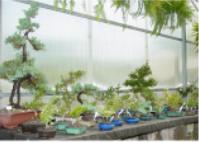 |
|
What can be made into Bonsai?
 |
Although any tree or shrub can be planted into a pot and trained into bonsai, in order to maintain the miniature look of bonsai, trees with naturally small features are typically used as bonsai material. Some common varieties include Japanese Maples, Chinese Elms, Junipers, and Serissa, to name a few. Some plants are used for their special features, such as Wisteria for it's long purple or white blooming ability, or Crabapple for it's blooming and fruiting ability. |
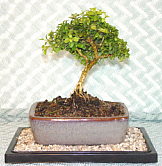 |
| |
|
| |
| Some basic tree categories: |
Tropical/Subtropical
Tropical and Subtropical bonsai trees are commonly grown indoors all year round. Some bonsai types include Ficus, Serissa, Fukien Tea, Brush Cherry, Bougainvillea, Dwarf Umbrella, and some Elms. There are many different varieties within each family of bonsai. For example, Serissa includes Japanese Pink Serissa, Snow Rose Serissa, and Chinese Serissa, to name a few. Many tropical/subtropical bonsai are easily maintained as indoor bonsai all year round as long as watering and lighting needs are maintained.
|
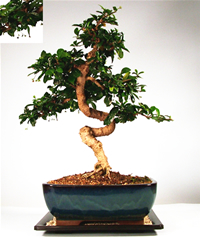 |
|
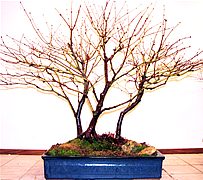 |
Deciduous
Deciduous bonsai trees annually shed their leaves in winter as they enter their winter dormancy period. Deciduous bonsai include Maple, Larch, Crabapple, Apricot, Hornbeam, Gingo, and many Elm species, to name a few. Deciduous bonsai are not suitable for growing indoors during the winter months because they require their winter rest period, which is facilitated by the colder weather. Deciduous bonsai are known for their Spring and Fall foliage color changes. Colors typically range from yellow to oranges to deep reds. |
|
Evergreen
Evergreen bonsai trees maintain their foliage throughout the season changes. Evergreen bonsai types include Junipers, Boxwoods, most Pines, and Azalea, to name a few. Some evergreen bonsai exhibit a dull green or yellowish tint to their foliage during their winter dormancy period. Most evergreen bonsai require a winter dormancy period, or rest period, in order to maintain their ongoing health.
|
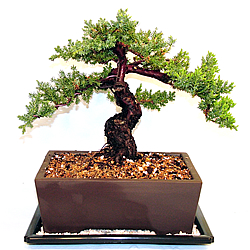 |
|
Some Basic Tools
There are many different types of tools that are used to create bonsai but we have created many bonsai with three basic typed of tools. The three basic tools are basic scissors, concave cutters, and a chopstick. |
Basic Scissors
Scissors are used to cut the foliage, smaller branches, and roots. There are many specialized types of scissors. No matter what your scissor of choice may be, it is important to maintain a sharp edge on all of your tools in order to cleanly cut through branches and not smash them. Cutting branches cleanly helps to promote healing and reduces the chances of disease. Scissors used to cut branches should be kept separate from those used to cut roots. Scissors used to cut roots dull much more quickly than those used to cut branches. In keeping two separate sets of scissors you will ensure that your scissors used to prune foliage and small branches are kept sharp.
|
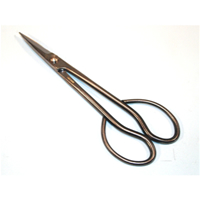 |
|
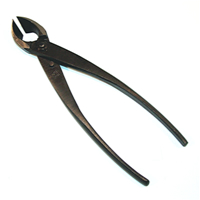 |
Concave Cutters
Concave cutters are used to cut larger branches. Concave cutters cut a small indentation into the truck or branch in order to facilitate healing. As with all bonsai cutting tools, a sharp edge should be maintained in order to cleanly cut through branches and not smash them. Clean cuts help to promote healing and reduce the chances of disease on the freshly cut surface. We consider concave cutters the second most important tool used to prune and train bonsai. |
|
Chopstick
We use a basic bamboo chopstick for many purposes including working new soil into the freshly planted bonsai and separating roots from old soil. By gently working the chopstick back and forth (not poking) during the potting process, new soil can be introduced into the old root ball. Gently working the new soil into the old root ball helps to introduce new soil into existing soil and reduces any air pockets within the soil. In a similar fashion, the chopstick can be used to separate roots within the root ball. By gently working the chopstick back and forth within the root ball, roots can be gently separated from the root ball, where they can be easily trimmed or removed.
|
| Some Basic Supplies
Along with tools, there are some basic supplies that you will need to produce your bonsai. These include pottery, soil, and training wire. |
Pottery
Bonsai pottery comes in many sizes and shapes. It is usually made of a clay material, although inexpensive plastic bonsai containers are available. Bonsai containers contain drainage holes in their bottoms so that excess water can drain from the container. Bonsai containers come in glazed and unglazed clay. Unglazed clay containers can be various shades of gray, dark green, or brown depending on the type of clay. Because bonsai pots contain drainage holes in the bottom, screens must be used to hold soil in the container.
|
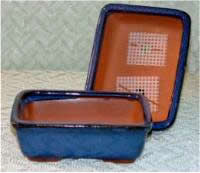 |
|
 |
Soil
The type of soil used to plant bonsai depends upon the type of tree planted. Evergreen trees typically enjoy more humus or pine bark in their soil than do tropical plants. Tropical plants commonly enjoy more sand in their soil. Our basic soil mixture is composed of the following:
1 part ProMix BX
1 part coarse sand
1 part Turface |
|
| Turface is a coarse clay material that is commonly used on baseball fields to manage water. Some other popular soil mixtures are as follows: |
Mix A
50% River Gravel
35% Turface
15% Bark |
Mix B
3 parts terragreen
2 parts peat
1 part soil |
Conifers
50% Sand
25% Leaf Mold
25% Earth |
|
|
| There are many types of soils and more and more additive options to choose from as you search around. This can make soil and additive selection confusing. There are two very important key elements to keep in mind. Make sure that your mix drains water well and make sure it contains organic material. |
Quick Note On Mass Produced Bonsai with Glued Stones on Top of the Soil
|
We receive quite a few questions regarding mass produced bonsai trees purchased at a good price from local superstores. While the trees themselves are ususally commonly used bonsai trees, the main concern pertains to the stones that are typically glued on the top of the soil. Here are a few of our thoughts and suggestions:
- The stones on the top are used by the manufacturer to keep the soil in the pot during shipping and at the retailers location. We suggest that you remove them from the top of the soil. In our experience the stones make it difficult to water and it takes longer for the plant to dry down.
- The soil used is typically a peat moss mix that is commonly used for house plants. It seems to hold water. We would suggest changing it out.
- Typically the pots are plastic, although we have encountered a few ceramic pots. We would suggest buying a ceramic bonsai pot and a bag of bonsai soil. If you purchase a pot that is slightly larger than the current pot, it is very easy to transplant from the small pot to the larger pot with minimal effort.
|
|
|
Training Wire
Training wire is used to train the bonsai branches the way that you want them to grow. Wire is typically anodized aluminum or solid copper. The wire is placed on the tree wiring two branches together or a branch and the truck together, winding the wire in a 45 degree angle snug around the trunk and branches. Wire is removed within a few months before the trunk and branches begin to grow around the wire, creating undesirable wire marks. Snub nose wire cutters are available to cut wire close to the trunk and branches. The wire should be cut off in small sections and not unwound. Unwinding the wire can result in damage to the delicate branches. |
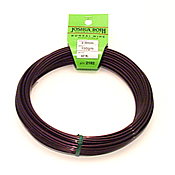 |
|
| Pruning and Design Guidelines
There have been more than quite a few books written on the pruning and design aspects of bonsai. A handful of the many guidelines form the fundamental basics of bonsai. Below we will outline a few of the most important guidelines. For more in-depth explanations and to learn more we would suggest you further your readings in one of the many good books written on the art of bonsai, as this serves as only a brief overview. |
Viewing Aspect
You may not realize at first glance, but bonsai is meant to be viewed in a certain position. That is, a bonsai tree has a front, a back, a right side, and a left side. How can you tell the difference? The front shows an open truck line. The front is typically free of branches sticking straight out from the trunk towards the viewer except for the very top, or apex, of the tree. The back shows depth by extending branches from the back of the truck, the exact opposite approach as the front. The sides show alternating branches. The following is an example:
|
 **Spruce Displayed at The National Arboretum in Washington DC **Spruce Displayed at The National Arboretum in Washington DC |
Pruning Basics
The following are some pruning basics to keep in mind while shaping and pruning your bonsai:
|
- Prune away branches and foliage around the base of the tree. Usually about ¼ to 1/3 of the way up.
- Prune all branches and foliage from the inside of curves in the trunk of the tree.
- Prune foliage on the main branches that is located close to the truck.
- Prune branches and foliage that is pointing straight up, except for the top of the tree (apex).
- Prune all branches and foliage pointing straight down.
- Prune branches and foliage pointing straight forward from the truck and branches, except for the top of the tree.
- Branches should alternate from left to right to back or from right to left to back. Branches should not be located straight across from one another.
- Pot in a porous well draining soil.
|
These are only a few of the many guidelines associated with the designing your bonsai. They are important guidelines but it is important to also realize that beauty is certainly in the eyes of the beholder. Have fun developing and training your bonsai and don’t get too wrapped up in the rules unless you plan to compete. Unless you are planning on entering your bonsai in a competition, trim and design your bonsai so that it looks pleasing to you.
Have fun with your bonsai!
|
The Sleepy Hollow Staff
|